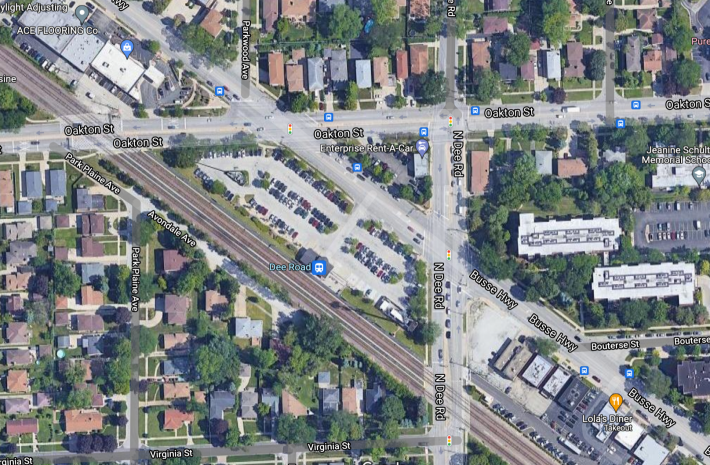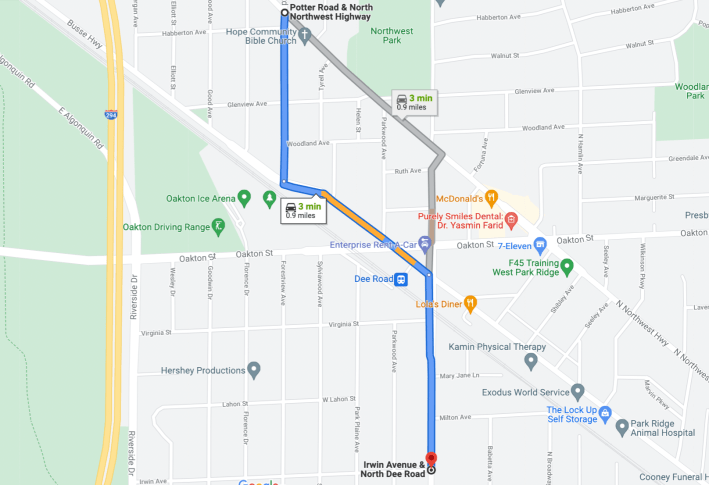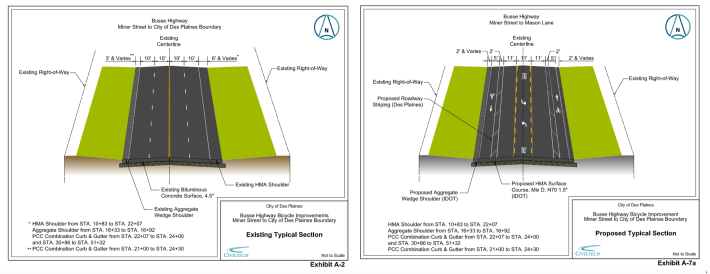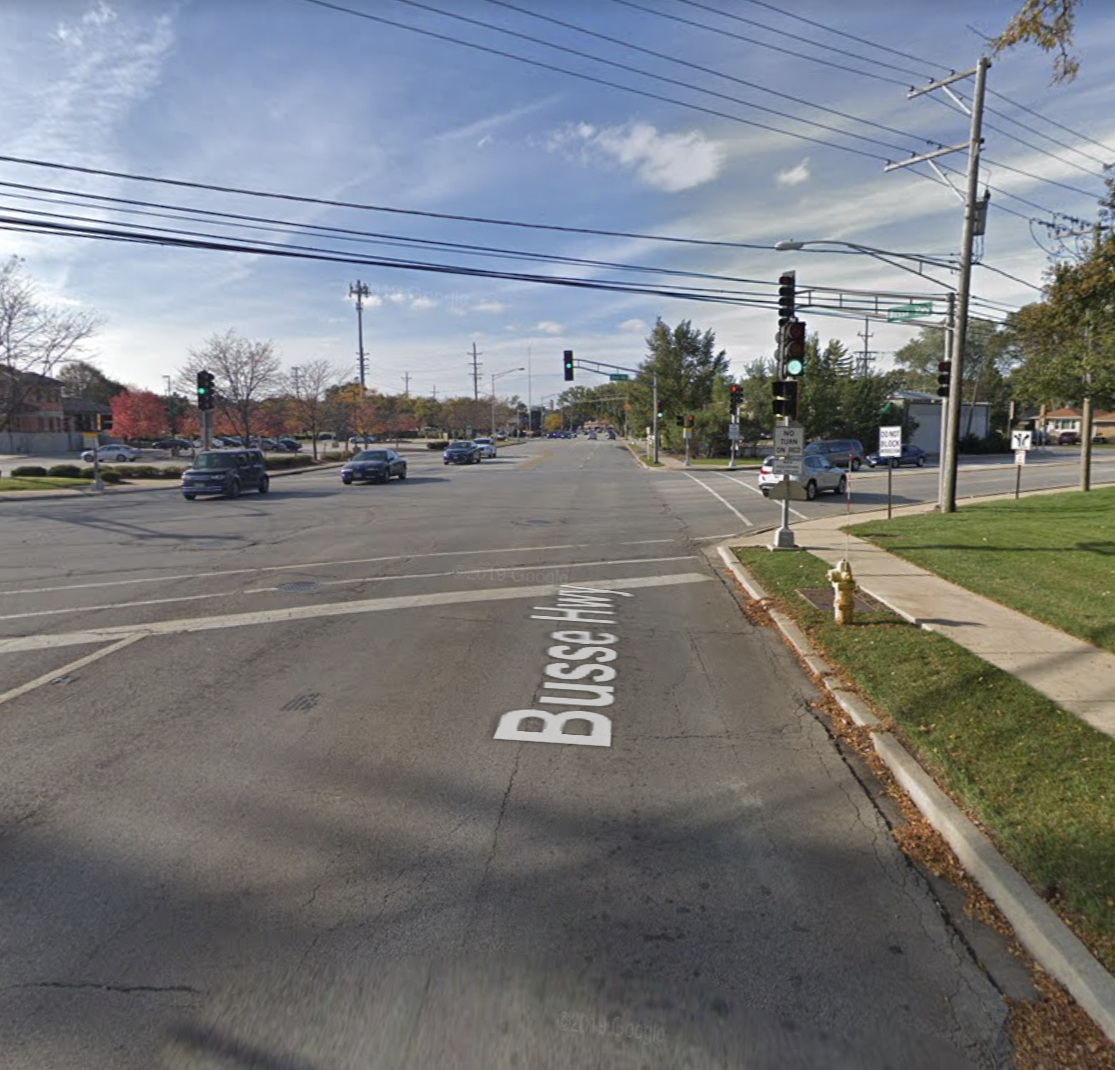If you're not familiar with the controversy over proposed bike lanes on Busse Highway in northwest-suburban Park Ridge, you can read this post for background. But here's a quick summary of what's going on.
Park Ridge and neighboring Des Plaines have proposed striping non-protected (traditional and/or buffered) bike lanes on Busse, a northwest-southeast diagonal street, between Touhy Avenue and the Des Plaines River Trail as part of a future repaving project. The bikeway plan would generally involve doing a four-to-three conversion road diet to calm traffic and make room for the bikeways. But on the roughly 1,000-foot stretch between Parkwood Avenue and Potter Road, shown in red on the map below, the Illinois Department of Transportation is asking Park Ridge to either eliminate about 18 on-street parking spaces, or else spend an estimated $300,000 to widen the segment. If Park Ridge doesn't cooperate, IDOT is threatening to kybosh the entire bike lane project.
Park Ridge officials and merchants have balked at IDOT's request, saying all the on-street parking is needed, and the city (understandably) doesn't want to spend money for road-widening, which would require cutting down trees, among other impacts.
The claim that all those parking spaces are needed is questionable, seeing as how every commercial and residential property on this stretch has a parking lot. On the other hand, the best solution appears to be implementing a road diet, as is planned on most of the rest of Busse. Doing so would calm traffic and provide the needed right-of-way for the bike lanes without parking removals or road expansion, so it was puzzling why that alternative isn’t on the table.
IDOT recently got back to me with its rationale. "More than 10,200 [drivers] travel along Busse Highway, between Oakton Street and Dee Road [a short stretch just south of the Potter-to-Parkwood segment] per day," said spokesperson Maria Castaneda. "Due to the high traffic volume, a road diet along certain sections of this stretch would not provide the needed safety and operational requirements to carry vehicles thru these intersections mainly in the Park Ridge section."
However, the usual rule of thumb, the one used by the Chicago Department of Transportation, is that four-lane streets that average up to 20,000 motor vehicle trips per day can be converted to two lanes plus a turn lane without causing undue congestion.
But Castaneda provided the following arguments against doing a road diet on Potter-to-Parkwood and Oakton-to-Dee (the following are her words.)
- "The signalized intersections of Oakton Street at Busse Highway, Oakton Street at Dee Road and Busse Highway at Dee Road are very closely spaced with little storage between the intersections. Eliminating a traffic lane would cause traffic to back through adjacent signalized intersections which would cause unacceptable delay and the potential for an increase in the frequency and severity of crashes."

- "The intersections of Oakton Street at Busse Highway and Busse Highway at Dee Road are interconnected to the [Metra Union Pacific Northwest line] tracks running parallel to Busse Highway. During train events, the intersections must provide a track clearance interval for safety. This requires stopping traffic along Busse Highway, adding to queuing concerns at the two intersections."

- "Potter Road and Dee Road act as a north-south couplet. For example, traffic turning off of Potter Road onto Busse Highway continues along Busse Highway and turns onto Dee Road. This adds a large amount of traffic on Busse Highway through the section between Potter and Dee roads, current traffic is nearly 11,700 vehicles per day."
Castenada noted that the original proposal called for keeping all four lanes on the Potter-to-Parkwood segment, as well as all the parking, and simply installing shared-lane markings, aka “sharrows” – bike-and-chevron pavement markings directing bicyclists and drivers to use the same travel lane – instead of actual bike lanes. "IDOT has concerns for the safety of the bicyclists riding mixed with vehicles who already have many complicated traffic movements to pay attention to through the triangle area," she said. "Additionally, the Manual for Uniform Traffic Control Devices does not allow for the installation of these markings for multi-lane treatments over 35 mph [which is the speed limit on the relevant section of Busse] and IDOT policy does not allow for this installation [of sharrows] based on traffic volumes and speed."
So that's IDOT's explanation for why it won't do a road diet between Dee and Potter, but it also won't allow Park Ridge to simply install sharrows. But this leaves bicyclists seemingly between a rock and a hard place. How can this impasse be resolved?
The Active Transportation Alliance has talked with local advocates and officials about this issue, according to ATA spokesperson Kyle Whitehead. "Local advocates and leaders have put in a great deal of time and effort pushing forward a vision for safer biking along Busse Highway. A full road diet with separated bike lanes would have the greatest safety impact, but if parking removal from Potter to Parkwood is not happening, sharrows for this stretch are better than scrapping the full project. The worst outcome is the status quo: an unsafe street that leaves vulnerable people walking and biking at greatest risk."

Park Ridge mayor Marty Maloney has said he plans to lobby state legislators to pressure IDOT to budge on the sharrow issue. Assuming that the parking removals are a non-starter (although they really shouldn't be), that seems to be the best was to overcome this impasse. After all, compromising with a short stretch of sharrows in order to allow for a road diet with bike lanes on the rest of the project area would be far safer than the status quo, for drivers, pedestrians, and bicyclists alike.





